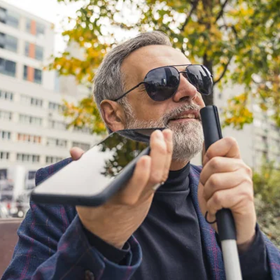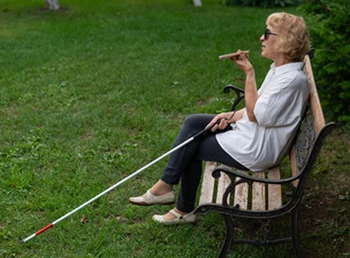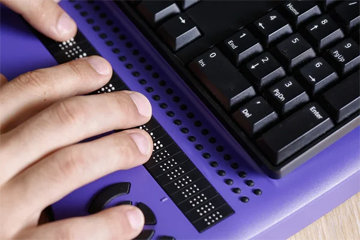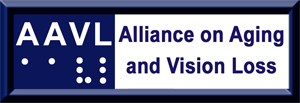Technology has vastly eased life for blind and low vision persons. Screen readers and magnifiers first opened the computer world, then voice control features and audible apps made smart phones accessible. Home speakers run by artificial intelligence and smart phone apps designed for the visually impaired can assist in a myriad of ways. There are also two companies that provide special glasses to help with navigation, reading and other tasks. New skills and apps are continually being developed, portending even more help in the future.
-
Both Microsoft and Apple have built screen magnifiers in their computer operating systems. Zoomtext is a commercially available screen magnifier that offers further enhancements. Microsoft’s Narrator and Apple’s VoiceOver are screen readers that read aloud what appears on a computer screen, whether it is a web site, email, document or other text sent to you or things you type. Commercial screen readers include NVDA and Window-Eyes, which work on computers running on Microsoft’s operating system, and JAWS (Job Accessibility With Speech), which works on both Microsoft and Apple operating systems and which is more expensive than the other screen readers mentioned but which many consider to be a superior product.

-
Apple’s iPhone was the first smart phone fully accessible to low vision and blind persons. It contains a magnifier and other features that improve contrast for low vision users. It also has VoiceOver which allows the user to hear whatever is touched on the screen. Many developers of apps for the visually impaired often make them first available on iPhones. Phones running on the Android operating system now also have magnification and contrast features and Voice control.
- The leading home speakers are the Amazon Echo and Google Home. Both are free standing plug in speakers that rely on the Internet and Wi-Fi connections. They respond to voice commands that can be made from across a room. They can tell the time, describe and forecast the weather, play music and radio stations, read audible books, offer news briefings, provide recipes, play games, tell stories and jokes, answer trivia questions, set alarms and timers, give reminders, place orders and perform many other functions. New skills are frequently added by automatic updates. Prices for both are comparable and mini versions are available that are less expensive and occasionally offered at significant discounts.
-
Smart phones also contain voice operated artificial intelligent assistants. These include the iPhone Siri and the Samsung Galaxy Bixby. Microsoft also offers Cortana on its computers and tablets. These typically require much closer proximity to use.

-
Microsoft has developed two smart phone apps specifically to assist visually impaired people with basic tasks. Seeing AI will scan and read documents, recognize and read labels, recognize faces and describe people and scenes. SoundScape will describe what is around you as you walk or ride to assist in navigation. Both apps are free. Voice Dream is an app similar to SeeingAi, and SuperSense is an app similar to SoundScape. Both can be purchased at set charges.
-
Google has developed an app for Android phones called Lookout which performs functions similar to Seeing AI. It can be downloaded for free from the Google Play store.

-
Be My Eyes allows you to call a sighted volunteer who can see through the camera on your smart phone. You can ask the volunteer to read a label, identify a color, help you find something you dropped or clean something you spilled, or answer other questions you may have that require vision. The app also allows you to seek specialized help from companies and organizations including Microsoft and Google. There is no cost for any of this. The app also offers Be My AI. If you choose this option, you take a picture on your phone and then it will be described through the use of artificial intelligence. You can ask for further description of items in the picture. For example you can ask for cooking instructions and nutritional information on packaged food items. There is no cost for this. New Ray-Ban glasses paired with the Meta View app can perform a similar function. You can ask what is in front of you and receive an answer based on artificial intelligence. You can ask further questions about the items seen. The advantage of using the glasses over Be My AI is that they are hands free. You can also call a friend through the glasses who can see what is in front of you and offer descriptions. The current charge for the glasses is around $300.
-
TapTapSee also uses the smart phone camera to read labels and identify objects but this is done through artificial intelligence and no live person is involved. Thus no questions or requests for clarifications can be made. The app is free.
-
BlindSquare is a navigation app. It will identify cross streets and places of interest around you as you walk or ride. It can also be programmed to guide you to a particular location. It can set an electronic marker at a chosen location. It is not free.
-
OKO is an app that provides audio and vibration notice of Walk and Don’t Walk signs. It also helps users avoid veering into traffic when crossing streets that have such signs. Currently it is only available for iPhone users.
-
VizLens will read aloud the text on flatscreens such as on home appliances or kiosks using OCR once you take a picture of the text. As you move your finger along the flatscreen, it will read the text under your finger.
- EyeNote is an app that identifies dollar bills. It can tell the denomination of a bill regardless of whether it is upside down and which side it is showing. The app is free.
- There are other apps developed for visually impaired persons such as ClickAndGo, BeSpecular and ColorID that may be of assistance.
- Several apps for the general public also provide services that those with low or no vision may find especially helpful. Amazon is the largest e-commerce app. Instacart is the most popular app for ordering groceries and related products for home delivery; Shipt is another similar service. Lyft and Uber provide rides in minutes. Each of these apps is accessible using the smart phone audible accessibility setting. GoGo offers similar services for transportation and food delivery via phone call for a slight additional fee. You can order restaurant meals from Grubhub, DoorDash and Uber Eats.
-
AIRA and Orcam offer special glasses with an imbedded camera to assist with daily activities. AIRA’s glasses allow a trained guide to see where you are and what is around you. The guide will assist you with navigation and other tasks such as shopping. The Orcam glasses rely on artificial intelligence, rather than live guides. These glasses read text, recognize faces and identify objects. These products are fairly costly. Orcam has a high upfront cost while AIRA relies on an expensive subscription service. However, certain stores including Wegmans and Walgreens have contracted with AIRA to allow their patrons to use its services for free when shopping in their stores, utilizing the cameras in their smart phones rather than AIRA’s special glasses. In addition, you can use AIRA for free for up to five minutes per day using the app and camera on your smart phone.
-
The foregoing and other suggestions are contained in Access World, a publication of the American Foundation for the Blind, at the following link:
https://www.afb.org/aw/21/2/16907?utm_source=AFB&utm_campaign=c2f466bf10
-
Innosearch.ai is a new web site specifically made for blind and low vision persons to shop for store items and flight tickets in an accessible manner. It is driven by AI and uses a format easily accessed by JAWS, a leading screen reader. Items can also be purchased by calling Innosearch at 855-746-7478. Shipping is free though shipping times are notclearly stated. Vendors include leading retail stores and airlines. Prices are the same as charged by such companies.
-
The following companies have the dedicated phone support lines listed below for people with disabilities:
Amazon - 888-283-1678
Apple - 877-204-3930
Comcast - 855-270-0379
Microsoft - 800-936-5900
